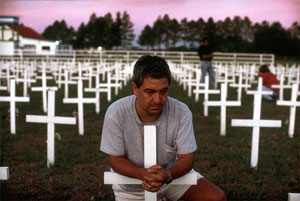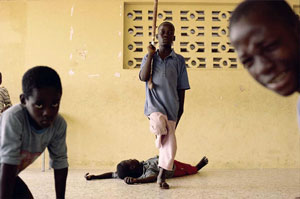 |
→ April 2005 Contents → Feature
|
War Without End
|
 |
|||||||||
|
When I was 12 I moved with my parents to the quiet, leafy suburbs of London, away from the bustle of the noisy highway that ran in front our previous home. We soon found out that the peace and calm of our new surroundings was not to be total, however. Several times a month the still night was shattered by the sound of a man screaming, something that terrified this child until my father found out that one of our new neighbors had been interned in a Japanese prisoner-of-war camp during the Second World War, an experience that continued to haunt his dreams. This was in 1954, and the war had been over for nine years, but for him, and many like him, the war would never end.
This is the conflict that Lori Grinker so brilliantly captures in her imposing new book AFTERWAR: Veterans From a World in Conflict, the tortured world of the veteran fighting both internal demons and external disabilities many years after the battles in which they were maimed have passed into our collective memory. One of the veterans that she photographed, Henry Green, a member of the British forces that fought in Korea, is quoted as saying, “We never thought that 40 years on we would be in the state we’re in. I don’t think it ever ends.” Something that Grinker discovered on her epic journey through this damaged landscape is that it doesn’t matter whether you fought in a “good” war, whether you won or lost, whether you believed in your cause or not, the trauma that is combat leaves nobody unscarred.
She photographed and interviewed combatants of most of the major wars of the 20th century from the First World War on, as well as a couple at the beginning of the 21st. Of the over 150 world conflicts fought in the 20th century, 24 are represented in Afterwar. The conflicts are presented in reverse order, the most recent being first, with a brief description of the war on the opening page of every chapter, and a timeline at the foot of each page showing when the conflict occurred and its duration. This device makes the reader aware that not only does war not end for the individuals involved, it also has no ending as a human activity, that on any given date somewhere on this planet people will be killing people for one cause or another. As well as telling the stories of the fighters, Afterwar also documents the continuum of conflict of the troubled century we have just left behind. This was important to Grinker as she explained in a recent interview with The Digital Journalist. She described why she wanted to interview veterans whose experience of combat was behind them. “It was important that they [the veterans] had some sense of perspective and that the reader gets a sense of history. It was like a time travel through the 20th century, bringing together a collective story of war with the different parts being all these different conflicts.”
One of the things that will surprise many American readers, who are only just getting used to the idea of women in the line of fire, is the number of female veterans that the book includes. The fighting force in Ethiopia on the Eritrean side was 40 percent female, many of them pregnant. “One of them thought I was very brave to be traveling around by myself,” Grinker said. “They would be seven months pregnant on the front, then leave, have their babies, put them into a crèche and go back and fight, but they didn’t see this as courageous.” She explained that these women felt they didn’t have a choice to fight because of the injustice that they saw around them, and that because they won the war they really improved the rights for women in their country.
If wars change little in the countries where they are fought, the changes they make in the people who fight them are profound, so deep in fact that they isolate those that have experienced combat from those who haven’t. “It’s a very private society,” the photographer believes. “Many people wouldn’t tell me stories because they said ‘we’ve never told our own families; why would we tell you?’”
Two patients in the Ty Gwyn Center for Post-Traumatic Stress Disorder in Wales expand on this idea. Steve Annabell, a veteran of the Falklands War says, “They program you to have no emotion – like if somebody sitting next to you gets killed you just have to carry on doing your job and shut off. When you leave the service, when you come back from a situation like that, there’s no button they can press to turn your emotions back on. So you walk around like a zombie.” His fellow patient, Graham Cunningham, who served with the British Army in Northern Ireland, feels that “the people on civvy street just don’t understand. The only people we can speak to is one of us. Only someone who’s been there can know.” He goes on to say, “I tried suicide and the rope broke.”
Because war is always the result of failure – failure of diplomacy, failure of understanding, failure of communication – veterans are a reminder of our failings, and thus we tend to brush them under society’s mat. Except of course for the ones that are presentable enough to be hailed as heroes and used as an inducement to the next generation of young men and women to heed the call of glory.
The power and the strength of this book is that it shatters the myth of the glory of war in ways that conventional war photography often cannot. Even the searing images of David Douglas Duncan or Don McCullin retain trace elements of heroism and adrenaline. The damaged men and women that populate the pages of Afterwar may be deserving of our sympathy and admiration, may have a nobility that has survived and even been strengthened by their wrenching experiences, but few would want to fill their shoes or emulate their suffering.
It is important to Grinker that the work is seen by as many of the next generation of potential recruits as possible. Not only is the project in the form of the book, but there was a successful exhibit at the United Nations building in New York, as well. Grinker has hopes of it becoming a touring exhibition. She expresses her frustration when she says, “What I don’t understand about the United States and this administration especially, is why they’re so uptight about any references to sex and nudity, but we have so much violence on television and that’s okay. I can’t get my head around that. Why is that okay? It’s as if they want to give young people a taste of violence, without any ‘real danger.’ It’s just a movie or a game. It’s fiction. In some ways I think it’s a way to militarize young people. It’s so hypocritical, and I don’t know how we can change it other than by showing what war really does. The reality of war is very different.”
In his moving introduction to Afterwar the war correspondent Chris Hedges says, “Those you have most in common with when the war is over are those you fought.” Those of us who have never shouldered a rifle, nor squeezed its trigger and seen a human being crumple before our eyes as the result, may never fully understand the damage, both physical and psychological, that combat causes. But those of us who read this book and are touched by the stories and pictures that it contains may move a little closer to such a comprehension, and may realize that the veterans who were our proxies in the dark acts of war bear a burden that we will also only imperfectly understand.
(AFTERWAR: Veterans From a World in Conflict, Photographs and Interviews by Lori Grinker. Published by de.MO, Edited with Robert Pledge, Text with Jacques Menasche)
© Peter Howe
Executive Editor
|
||||||||||
Back to April 2005 Contents
|
|


